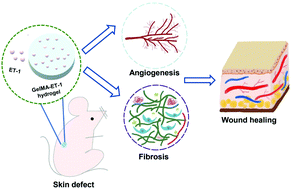Gelatin methacryloyl hydrogels functionalized with endothelin-1 for angiogenesis and full-thickness wound healing†
Abstract
Natural polymer hydrogels are widely used as wound dressings, but they do not have enough bioactivity to accelerate angiogenesis and re-epithelialization. Herein, a therapeutic system was firstly constructed in which endothelin-1 (ET-1), as an endogenous vasoconstrictor peptide, was embedded in a photo-crosslinking gelatin methacryloyl (GelMA) hydrogel for full-thickness wound healing. The multifunctional GelMA–ET-1 hydrogels contained the arginine–glycine–aspartate (RGD) motifs of gelatin that provided adhesive sites for cell proliferation and migration. The ET-1 was wrapped within the network of crosslinked GelMA hydrogels via intermolecular hydrogen bonding interactions, effectively avoiding oxidization by atmospheric oxygen and in vivo enzymatic biodegradation. Notably, the ET-1 in the functional hydrogels significantly promoted the proliferation, migration and angiogenesis-related gene expression of human umbilical vein endothelial cells (HUVECs) and fibroblasts. The full-thickness skin defect model of rats further revealed that the GelMA–ET-1 hydrogels significantly accelerated new blood vessel formation, collagen deposition and re-epithelialization. After 14 days, the full-thickness skin defects almost closed and were filled with the newly formed tissue. Hence, the photo-crosslinking GelMA–ET-1 hydrogels functionalized with ET-1 can be employed as a promising therapeutic system for wound healing.



 Please wait while we load your content...
Please wait while we load your content...